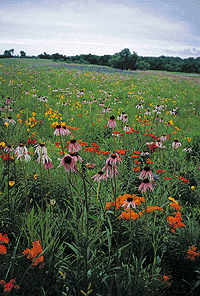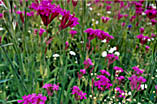How About a Wildflower Meadow?
 When driving around Ohio, it is not uncommon to see
roadside area plantings of wildflowers. Can you duplicate the
roadside planting at home, and what are real world expectations
from such plantings? Dr. M. Knee of Ohio State University offers
information on wildflower planting:
When driving around Ohio, it is not uncommon to see
roadside area plantings of wildflowers. Can you duplicate the
roadside planting at home, and what are real world expectations
from such plantings? Dr. M. Knee of Ohio State University offers
information on wildflower planting:
A wildflower garden can be many different things for different
people. Common expectations are that it will be informal, with a
wide diversity of flowers, providing a rewarding prospect with
little investment of time or money. "Wildflower"often
refers to an appearance rather than a definite group of plants or
garden treatment. The terms "natural" or
"naturalistic" are also likely to crop up, raising the
idea that this kind of garden might resemble an ecosystem that
would develop if nature took its course.
Commonly available wildflower seed mixes include a selection
of annuals, sometimes selected for growth in a particular region,
such as the northeastern United States. These may include Ohio
natives such as black-eyed Susan ( Rudbeckia hirta),
U.S. natives such as Coreopsis tinctoria, and
non-natives such as poppy (Papaver rhoeas) and Mexican
aster (Cosmos bipinnatus). They may even include weedy
species such as  Queen Anne's Lace (Daucus carota)
or corn marigold (Crysanthemum segetum). These mixes are
inexpensive and easy to establish by broadcasting seed in a sunny
area. They can be a rewarding short-term treatment for an area
that just needs to be filled with something colorful. Many of the
species will self-seed and this can be encouraged by cutting the
dry stems and shaking them over the plot area. Over time, the mix
of flowers tend to get less interesting as one or two species
become predominant. This can be managed by removing seed heads of
the more abundant species and adding seed of more desirable
species as the years go by.
Queen Anne's Lace (Daucus carota)
or corn marigold (Crysanthemum segetum). These mixes are
inexpensive and easy to establish by broadcasting seed in a sunny
area. They can be a rewarding short-term treatment for an area
that just needs to be filled with something colorful. Many of the
species will self-seed and this can be encouraged by cutting the
dry stems and shaking them over the plot area. Over time, the mix
of flowers tend to get less interesting as one or two species
become predominant. This can be managed by removing seed heads of
the more abundant species and adding seed of more desirable
species as the years go by.
However well it is managed, this kind of wildflower
patch/meadow has a period of maximum show in mid summer and can
look dull or messy for much of the re st of the year.
st of the year.
Meadow and prairie mixes include mainly perennial plants that
take longer to establish than the annual wildflower mixes. Both
include a high proportion of grasses, and the flower color may
not be as striking as the annual mixes. On the other hand, the
seed heads of grasses and other species provide interest at other
times of the year.
Meadow mixes often include non-native grasses and wildflowers
in addition to natives. Prairie mixes are based on native warm
season grasses and forbs (plants with showy flowers). Examples
are big bluestem (Andropogon gerardii), Indian grass Sorghastrum
nutans), gayfeather (Liatris pycnostachya), and
prairie coneflower (Ratibida pinnata). The species will
all be U.S. natives, but many prairie seed mixes come from other
states such as Wisconsin and Minnesota, and some of the species
may not be native to Ohio. Some people insist on growing species
native to their particular area and try to find local seed
sources so that they can be sure that the plants are well adapted
to local soils and climate.
Meadow and prairie mixes require sunny areas and careful site
preparation before seeding. Existing vegetation must be killed.
It may take repeated cultivation or herbicide applications over a
year before planting to eliminate weed seedlings and perennial
weeds such as thistle. Seed can be sown in the spring or fall. It
is much easier to estabvlish meadows and prairie on low fertility
sites than where there is a high residual fertility that favors
fast growing weeds. It will take two or three years before these
areas look particularly attractive. Long-term maintenance may
require spot reatments of persisitent weeds and lowing at least
once a year in later fall or early spring. Prairies benefit from
occasional fire and burning may be possible in rural areas.
Wildlife Haven's
Home Page
 When driving around Ohio, it is not uncommon to see
roadside area plantings of wildflowers. Can you duplicate the
roadside planting at home, and what are real world expectations
from such plantings? Dr. M. Knee of Ohio State University offers
information on wildflower planting:
When driving around Ohio, it is not uncommon to see
roadside area plantings of wildflowers. Can you duplicate the
roadside planting at home, and what are real world expectations
from such plantings? Dr. M. Knee of Ohio State University offers
information on wildflower planting: Queen Anne's Lace (Daucus carota)
or corn marigold (Crysanthemum segetum). These mixes are
inexpensive and easy to establish by broadcasting seed in a sunny
area. They can be a rewarding short-term treatment for an area
that just needs to be filled with something colorful. Many of the
species will self-seed and this can be encouraged by cutting the
dry stems and shaking them over the plot area. Over time, the mix
of flowers tend to get less interesting as one or two species
become predominant. This can be managed by removing seed heads of
the more abundant species and adding seed of more desirable
species as the years go by.
Queen Anne's Lace (Daucus carota)
or corn marigold (Crysanthemum segetum). These mixes are
inexpensive and easy to establish by broadcasting seed in a sunny
area. They can be a rewarding short-term treatment for an area
that just needs to be filled with something colorful. Many of the
species will self-seed and this can be encouraged by cutting the
dry stems and shaking them over the plot area. Over time, the mix
of flowers tend to get less interesting as one or two species
become predominant. This can be managed by removing seed heads of
the more abundant species and adding seed of more desirable
species as the years go by. st of the year.
st of the year.